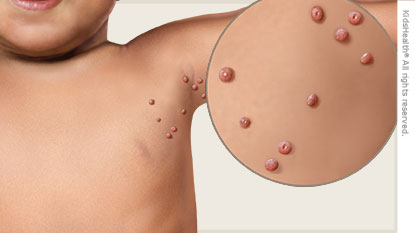What Is Molluscum Contagiosum?
Molluscum contagiosum is a skin rash caused by a virus. The rash has small clear or flesh-colored bumps. The bumps can spread from one part of the body to another or from person to person. For most kids, the rash goes away on its own in 6–12 months, but can take longer.
Molluscum contagiosum (mol-US-kum kon-tay-jee-OH-sum), or molluscum for short, usually goes away on its own without medical treatment.
What Are the Signs & Symptoms of Molluscum?
The rash is the telltale sign of molluscum. Its bumps:
- Start as very small spots about the size of a pinhead.
- Grow over a few weeks. They can be as large as a pea or pencil eraser.
- Are soft and smooth and may have a small dent in the center.
- Often are painless, but can get itchy, sore, red, and/or swollen.
- Can get infected with bacteria if kids scratch or pick at them.
- Can appear alone or in groups, or rows. Most people get between 1 and 20 bumps.
- Can show up almost anywhere on the skin except for the palms and soles. In kids, they're most often on the trunk, arms, and face.

What Causes Molluscum?
The molluscum virus causes the rash after it enters a small break in the skin. Bumps usually appear 2–6 weeks after that.
The molluscum virus spreads easily from skin touching skin that has bumps. Kids also can get it by touching things that have the virus on them, such as toys, clothing, towels, and bedding. Sexually active teens and adults with bumps in the groin or inner thighs can spread them to partners.
Molluscum most often happens in healthy kids 1–12 years old. But it also happens in:
- athletes who have close contact, such as wrestlers, or athletes who share equipment, such as gymnasts
- people with health problems treated with long-term steroid medicine use
How Is Molluscum Diagnosed?
Doctors can usually tell a rash is molluscum by looking at it. Sometimes they might suggest that kids see a dermatologist (skin doctor), but most kids won't need this.
Can Molluscum Be Prevented?
Kids with molluscum can still go to daycare, school, and sports. To prevent the spread of molluscum to other places on their body and to other people, they should:
- Wash their hands well and often with soap and water.
- Cover the bumps with clothing or a bandage.
- Cover the bumps with a watertight bandage before swimming or doing activities with close contact (like wrestling) or shared equipment (like gymnastics).
- Not share towels or pool toys.
- Not shave over areas that have bumps.
- Not touch, scratch, or rub the bumps.
How Is Molluscum Treated?
Most of the time, molluscum clears up on its own without treatment. Each bump goes away in about 2–3 months. New bumps can appear as old ones go away, so it can take 6-12 months (and sometimes longer) for molluscum to fully go away.
Sometimes, doctors remove the bumps or help them go away more quickly. To do this, they can:
- Freeze the bumps off.
- Scrape or cut the bumps off.
- Put a chemical on the bumps to make the body fight them away faster.
- Put medicine on the bumps or give medicine to swallow.
Many doctors don't recommend these treatments for kids, though. That's because they can be painful and burn, blister, stain, or scar the skin. When deciding to treat a rash, they consider where the bumps are and if they're causing itching, pain, or other problems.
How Can Parents Help?
To avoid molluscum and other skin infections, have your kids follow these tips:
- Wash hands well and often with soap and water.
- Do not share towels or clothing.
- Do not share kickboards and other water toys.
- Do not touch or scratch bumps or blisters on their skin or other people's skin.
Talk with your child's doctor about the pros and cons of treating molluscum. The rash usually doesn't cause long-term problems or leave scars. Often, the best way to handle it is to be patient, as hard as that might be.


